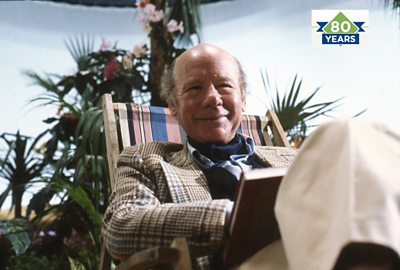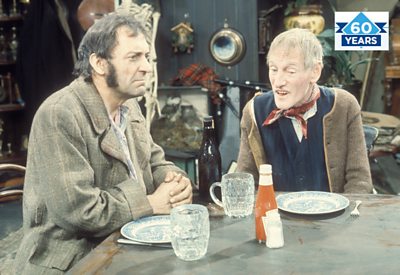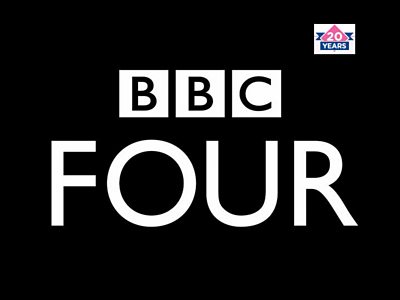Most of the anniversaries relate to TV and radio programmes, although we kick off our list with the official opening of Broadcasting House in 1932. If any of these items spark memories of working on these programmes or other notable events – or if there’s something we’ve missed – please get in touch with us at prospero@bbc.co.uk

Broadcasting House - 90 years
The 91�ȱ�’s landmark central London premises, Broadcasting House, officially opened on 15 May 1932. It was designed by Val Myer, with the 91�ȱ�’s civil engineer Marmaduke Tudsbery. Together, they overcame the restrictions imposed by the location on Portland Place to create a building that contained 22 sound-insulated radio studios and a concert hall, and is still in use today.
Broadcasting House survived the war despite being hit by a bomb which killed seven people. It was granted Grade II* listed status in 1981. At the start of the 21st century, a major refurbishment of the building accompanied the development of a massive extension, by architects MJP, which fitted Broadcasting House for life in the future.
It now houses 91�ȱ� News, 91�ȱ� Television, 91�ȱ� Radio and the World Service.
Desert Island Discs - 80 years
Desert Island Discs was devised by Roy Plomley, who presented the first edition on 29 January 1942. It was recorded two days earlier with comedian Vic Oliver, in the bomb-damaged Maida Vale Studios.
The success of the programme has always owed much to its simple format, which allows for sometimes revealing interviews. However, early programmes were scripted, to comply with wartime censorship.
Plomley’s original idea had been for Desert Island Discs to open with the sound of breaking waves and seagulls, but worries that this would prove too indistinct led to the addition of By the Sleepy Lagoon, by Eric Coates. The theme so impressed second castaway James Agate that he made it one of his choices.
Plomley presented 1,791 editions before his death in 1985. Since that time the presenters have been Michael Parkinson, Sue Lawley, Kirsty Young and Lauren Laverne. Today the format of Desert Island Discs remains unchanged, despite the rise of the mp3, but it has an impressive online archive of past shows. It continues to attract guests of the highest calibre.

Z Cars - 60 years
The first episode of Z Cars – broadcast on 2 January 1962 – brought a new type of police drama to British screens. It showed modern police in squad cars – Ford Zephyrs – dealing with the problems of the fictional Lancashire town of Newtown and with their own lives. Influenced by the kitchen sink dramas of the time, it quickly revealed the police were as human as everyone else. The show was created by Troy Kennedy Martin and proved an immediate hit, with viewing figures soon hitting 14 million.
Z Cars’ popularity was reflected in the pop charts in April 1962, when the theme tune reached number two. The show ran until 1978 and spawned spin-offs Softly, Softly and Softly Softly Task Force.

Animal Magic - 60 years
Animal Magic was first seen on 13 April 1962. The fortnightly children’s nature programme was made by the fledgling Natural History Unit, and presented by Johnny Morris, who provided voices for the animals and made them talk. On the first show he interviewed a Woolly Monkey.
Morris was occasionally criticised for anthropomorphising the animals, but the humour drew viewers into the more formal scientific elements of the programme. In the first edition these were provided by Tony Soper and Gerald Durrell.
Morris frequently filmed as Keeper Morris, at Bristol Zoo. He would then add voices to the animals on film. However, for many years most of the programme was live, and Morris thrived on the unpredictable and sometimes un-cooperative behaviour of the animals. Some creatures, such as Dotty the Ring-Tailed Lemur, became Animal Magic regulars.

Steptoe and Son - 60 years
The first series of Steptoe and Son began on 7 June 1962, with a repeat of the pilot. The Offer first aired as an episode of Comedy Playhouse, but the reaction was so favourable that writers Alan Simpson and Ray Galton quickly produced a full series. The simple set up featured a father and son relationship, and played out in the same cluttered junkyard set every week.
Its mixture of coarse comedy and pathos gave it universal appeal and ensured its success. Steptoe and Son ran until 1965, was revived in 1970 and lasted until 1974. The public appetite for the show was such that it spawned two feature films and a radio version, and was remade in America.

Newsround - 50 years
After an 11-year gap in broadcasting 91�ȱ� news to children and young people, John Craven’s News Round, as it was originally known on air, was broadcast live on 4 April 1972 on 91�ȱ� One Colour at 17.20.
Its predecessor, Children’s Newsreel (April 1950 - Sept 1961), had come to be seen as old fashioned, stuffy and inaccessible. Its style was very much like the serious Television Newsreel for adults, albeit with a simpler script, and different selection of stories. Regular 91�ȱ� announcers took turns in speaking the commentary. In short, that approach didn’t work for the swinging 60s. So, there were to be big changes.
Television Newsreel turned into the news bulletins we recognise today, but news aimed at children slipped off the agenda almost entirely. John Craven introduces a segment on the end of the war in Vietnam,April 1972. The provision of proper, regular news, aimed at younger viewers, had climbed up the pecking order in the 91�ȱ� Television Centre newsroom by the early 70s, but resources for a dedicated programme were few, and money was tight. In fact News Round went on air with only a handful of staff and two typewriters, relegated to a corner of the newsroom.
The programme’s debut could not have been more terrifying for those involved. In the transmission gallery, the director was in a terrible panic according to John Craven (now 72). ‘Right,’ he said, ‘two minutes left and I’ve only got three scripts, so everybody repeat after me: Our Father, which art in Heaven...’ Perhaps the Divine did intervene, as the programme survived its first hurdle – just. Curiously, no recording of that first edition exists.

I’m Sorry I Haven’t a Clue - 50 years
I’m Sorry I Haven’t a Clue was first broadcast on 11 April 1972. Billed as ‘the antidote to panel games’, the programme was conceived as a spin-off from popular comedy I’m Sorry, I’ll Read That Again.
The first episode featured ISIRTA regulars Tim Brooke-Taylor, Graeme Garden,Bill Oddie and Jo Kendall. Jazz trumpeter Humphrey Lyttelton was appointed chairman, and with the panellists established a pattern of daft humour and bad puns that won a cult following and several major radio awards.
The early shows sometimes referenced ISIRTA, but when Barry Cryer and Willie Rushton joined Garden and Brooke-Taylor as regulars, I’m Sorry I Haven’t a Clue developed its own distinct identity. Lyttelton’s deadpan style provided a brilliant contrast to the idiocy of the panellists. The teams played games such as singing the words of one song to the tune of another, and Mornington Crescent – whose rules were only known by the participants. Rushton died in 1996 and his place was taken by a succession of guests.
When Humphrey Lyttelton died in 2008 the show took a break. I’m Sorry I Haven’t a Clue returned the following year with Stephen Fry, Rob Brydon and Jack Dee hosting. Since then Dee has become the regular chairman, and the programme has continued to thrive, remaining fresh even though it has remained essentially unchanged.

Truly, Madly, Deeply - 30 years
Got its first television showing on 1 March 1992. The film was written and directed by Anthony Minghella, starring Juliet Stevenson and Alan Rickman. Minghella wrote the part of Nina for Stevenson. Rickman was very happy to play a role which was different from the cinema villains that had made him famous.
The film – made by 91�ȱ� Films – had already been a success in the cinema and won Evening Standard awards for Stevenson, Rickman and Minghella. The Radio Times made light of the plot: ‘Nina is a young woman unable to cope with the death of her lover Jamie. One day she misses him so much that he comes back!’
Truly, Madly, Deeply has romance at its heart and many comic moments, but is much more than a romantic comedy. The film features a harrowing depiction of grief – in intensely moving scenes with Stevenson. A fine supporting cast include Bill Paterson, David Ryall and Michael Maloney – who plays potential new boyfriend Mark. Stevenson has said that Nina in Truly, Madly, Deeply is her favourite role. Her range can be seen in contrasting 91�ȱ� dramas The Village and Atlantis.
Minghella went on to win an Oscar with The English Patient. He returned to the 91�ȱ� with The No 1 Ladies Detective Agency, shortly before his death in 2008. Rickman died in 2016, but his varied career included a return to the 91�ȱ� in 2010 for The Song of Lunch.

91�ȱ� Four - 20 years
The new digital television channel 91�ȱ� Four began on Saturday 2 March 2002. It was launched with the slogan ‘everybody needs a place to think’, offering a diet of arts, culture and documentaries. The new channel replaced 91�ȱ� Knowledge.
Controller Roly Keating explained in the Radio Times that 91�ȱ� Four would have the time to examine subjects in greater depth than had been possible on 91�ȱ� Two.
91�ȱ� Four’s first night was a simulcast with 91�ȱ� Two, acknowledging the links between the two channels and the need to showcase the potential of the new digital station to the far larger terrestrial audience. The first programme was The Man Who Destroyed Everything, about artist Michael Landy. This was followed by a documentary on Goya, a comedy drama on the Surrealists and music from Baaba Maal. 91�ȱ� Four also offered a distinctive international emphasis to the news, with a bulletin presented by George Alagiah.
91�ȱ� Four overcame initial reservations about the size of its audience to become a recognised home of intelligent programming, and won the award for Non-terrestrial Channel of the Year at the Edinburgh Television Festival. The channel has originated many acclaimed programmes, and made successes of subtitled drama series such as Wallender and The Killing, that would otherwise have struggled to find an audience.

